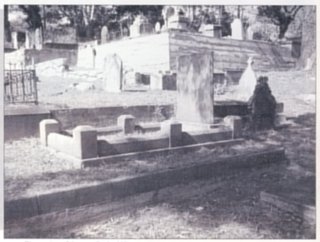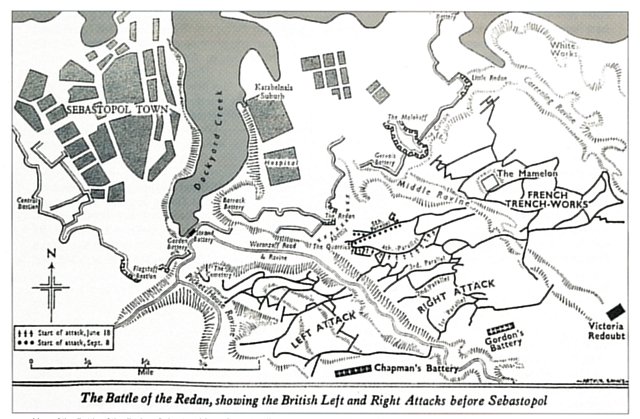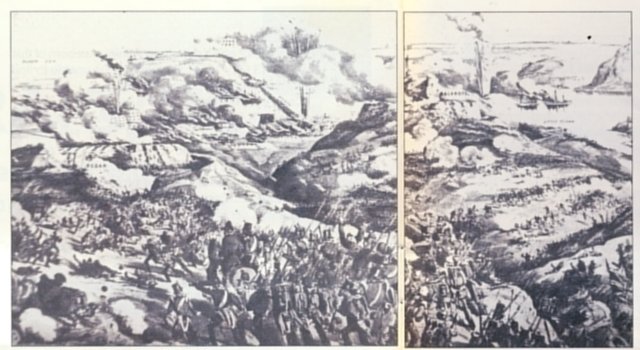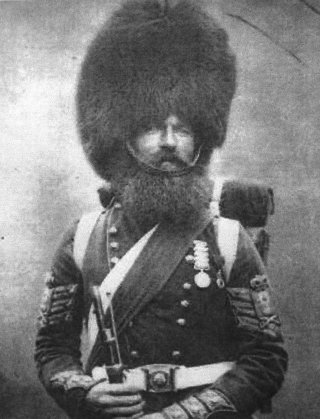

 The South African
The South African
The Victoria Cross (VC) recipient, Assistant Acting Commissary James Langley Dalton, who earned his medal for the considerable part he played in the defence of Rorke's Drift during the Anglo-Zulu War of 1879 and who is buried in the Russell Road Cemetery, Port Elizabeth, is well-known to Port Elizabethans and to South Africans generally, and is commemorated by a memorial ceremony which is organised by the Memorable Order of Tin Hats (MOTHs) at his graveside in January each year. Not so well known is the City's connection with an earlier VC winner from the Crimean War, James Craig.

The grave of James Craig, VC
(Photo: By courtesy, R Tomlinson, Port Elizabeth).
Early life
James Craig was born on 10 September 1824, the son of James Craig and Ann (nee Guthrie), at Balbeggie in the Parish of St Martin's, Kinnoul, Perthshire, Scotland. He was baptised two days later at the Kirk of Collace by the Rev Rogers of Perth (Haddon, 1979, p 1). Craig enlisted on 25 August 1843 with the Scots Fusilier Regiment of Foot Guards (now the Scots Guards) and attested to the same regiment at Perth the next day (Form A, Unlimited Service, Attestations for Regiments). On the attestation form, Craig's trade is given as 'Labourer' and his age as eighteen years and three months, which does not quite agree with his stated date of birth. This is understandable in those days, when family record-keeping in the labouring classes was perhaps not very accurate. Craig received a bounty of £2.1 0.0d for enlisting and an additional 15.0d when he signed the Oath of Allegiance to the Queen, a quite considerable sum of money in those days. His 'Articles of War' form is interesting as it spells out clearly the penalties if a soldier were to become involved in mutiny, sedition or desertion - 'Death, or such other Punishment as by a General Court Martial shall be awarded.' On this form, Craig is described as 5 feet 8.25 inches (1 ,73 metres) in height, with a fresh complexion, blue eyes, fair hair and no 'distinctive Mark'. He was given a clean bill of health by the Surgeon in London on 26 September and his application was finally approved by his commanding officer on 6 November 1843 (Articles of War form), so the preliminaries took two and a half months to complete.
Craig served as a private (No 3075) until he was promoted to the rank of corporal on 11 June 1846. After only five years in this rank, he was made a 'Serjeant' on 22 July 1851 and gained the rank of 'Color Serjeant' [sic] on 27 June 1855 (Record of Service). He was clearly a well-behaved soldier, as one of his papers relates that he received 'One penny per diem G[ood] C[onduct] Pay' from 26 August 1848. This award was apparently a very regular occurrence and was an attempt on the part of the regiments to reduce crime levels amongst their soldiers.
James Craig married Elizabeth Ann Scruse (or Scruze) at St Dunstan's Church, Stepney, London, on 17 March 1849 and a daughter, Annie, was born of this union, on 13 May 1850. The author was unable to find any further details of Craig's family.
Craig's papers record that he served abroad 'in the east' from 28 February 1854 to 15 January 1855 and that he re-embarked on 13 April 1855. Regimental records are not specific as to where this service occurred. The 1st Battalion was posted to Malta early in 1854 and it is likely that he proceeded with them from there to Bulgaria before the campaign moved to the Crimean peninsula.
Service in the Crimea
The Crimean War (1854-56) was the first European campaign in which Great Britain had been involved since the Napoleonic wars, and it was to show up how little the army had progressed and modernized during the intervening 40 years. France and Britain declared war on Russia when the latter attempted to wrest Constantinople and the Bosphorus channel from the ailing Turkish Empire; possession of these strategic points would have opened the gate for the Russian fleet to extend from the Black Sea into the Mediterranean. This was unacceptable to the allies who, in support of the Turks, blocked the Russian advance at the miserable Bulgarian port of Varna on the west coast of the Black Sea. The resulting impasse forced Russia to retire across the Danube and back to its own territory. There matters should have ended. But the British government, goaded by the public, decided 'the eye-tooth of the [Russian] Bear must be drawn' and opted for a Franco-British- Turkish invasion of the Crimean peninsula, on the north side of the Black Sea, with its heavily fortified capital port of Sebastopol.
James Craig was present at the battles of the Alma, Balaklava and Inkerman (in September, October and November 1854 respectively), at the last of which he received 'severe gunshots through both legs'. His period of absence between 15 January and 13 April 1855, shown in his service record, was probably sick leave to recover from his leg wounds. Ten months after Inkerman, he was sufficiently fit to serve in the line at the siege of Sebastopol. His service record states that he received a medal and clasps for his Crimean service.
In September 1855 Colour-Sergeant Craig was a member of the 1st Battalion Scots Fusilier Guards, which had been in the line in front of the Redan, the centre-point of the land defences of Sebastopol, from 19 June, without a break. The siege had not gone well, a particularly expensive Allied assault having been repulsed on 18 June, and was continuing by artillery bombardment and by 'sapping', which involved digging trenches towards the enemy objective, usually in a zig-zag plan to avoid enfilading fire, with 'parallels' at right-angles to extend the front (see the map and artist's impression).

Map of the Battle of the Redan, Sebastopol (now Sevastopol)
(Source: W B Pemberton, Battles of the Crimean War).
The making of a VC
The night of 6/7 September was the Battalion's last in the line and Captain D F Buckley had gone out in front of the advanced right sap to check on the sentries, when it was reported that he had fallen. Two sentries, Privates Allen and Sankey, were wounded at the same time. Craig and Drummer Thomas Smith volunteered to go out under heavy fire and bring in the wounded officer. They were assisted by Sergeant Donald McBeath, in charge of the section on this night, in the search for Buckley and then McBeath proceeded to bring in Sankey on his back, for which he was awarded the medal for Distinguished Conduct in the Field (DCM). Captain Buckley is briefly mentioned, incidentally, in Fanny Duberly's journal. (Fanny was the wife of Captain Henry Duberly, paymaster of the 8th Royal Irish Hussars, and a regular sightseer during the siege). She chatted to Captain Buckley two hours before he was killed and met his funeral cortege on 8 September, regretting that she could only 'show him what respect I can, although a black habit, and handkerchief, and a strip of crape round my arm, is all.'
Craig's citation for the VC reads: 'For having volunteered, and personally collected other volunteers to go out under a heavy fire of grape and small arms, on the night of 6th September 1855, when in the right advance sap, in front of the Redan, to look for Captain Buckley, Scots Fusilier Guards, who was supposed to be wounded. Serjeant Craig brought in, with the assistance of a Drummer, the body of that Officer, whom he found dead - in the performance of which act he was wounded.'
A second attack on the Redan on 8 September was almost a repeat of the June debacle forthe British, but the French on the right flank succeeded in breaking through. The Russians had had enough and quietly ended the siege by retiring from the ruined town that night, and the war was essentially finished.
On 26 January 1856 James Craig was appointed Cornet & Adjutant in the Land Transport Corps (subsequently the Royal Army Service Corps and now the Royal Logistical Corps). The reason for this move could have been a desire for a less exciting lifestyle, but it is most likely that he decided to transfer because prospects of promotion were better in another unit, and many men moved for this reason. He was probably still suffering the after-effects of his wounds and the extreme trauma incurred during his brave sortie, so this intervening period could also have been spent in hospital or on sick leave. However the transfer appears to have been made while Craig was still in the Crimea, as his service record with the Scots Fusilier Guards states that he finally left the Crimea on 20 July 1856.

An artist's impression of the fall of Sebastopol (Source: W B Pemberton, Battles of the Crimean War).
The award of the Victoria Cross to Craig was made by the War Office on 18 November 1857, over two years later, and promulgated in the London Gazette dated 20 November 1857. The Victoria Cross was only instituted in 1856, the first recipients being decorated with the new medal by Queen Victoria in June 1857. The Queen presented the medal to Craig and several other men at Windsor Castle on 21 November 1857. (This VC was sold at Christie's in London, on 25 January 1956, for £480 and is now deposited at the Scots Guards Regimental HQ Museum in London).
In January 1858 Craig was promoted to Lieutenant in the Land Transport Corps and, on 12 February 1858, we find him transferring to the 2nd Battalion 10th Regiment of Foot (North Lincolnshire Regiment). By this time he may have recovered sufficiently that he could no longer resist the temptation to re-enlist with an infantry regiment.

This photograph of Colour-Sergeant McPherson, Scots Fusilier Guards,
shows the type of uniform worn by C/Sgt Craig at the time of the Crimean War
(Photo: National Army Museum, England).
To South Africa
The 1st Battalion of the 10th Regiment was serving in India where the Mutiny had broken out on 10 May 1857. The 2nd Battalion was re-formed on 2 September that year at Mullingar, Ireland, due to the serious state of affairs in India and, by the following March, the Battalion strength had reached 852 men of all ranks. It was ordered to South Africa late in 1859.
The first contingent, under the command of Lieut-Col Thomas Byrne, embarked at Kingstown- (Dublin), Ireland, on 8 December 1859 and sailed on 11 December in HM Troopship Vulcan, arriving at Simon's Bay on 10 February 1860, and continued to Algoa Bay, arriving on 21 February. From there, the contingent of 14 officers, 13 sergeants, 3 drummers and 258 rank and file (and families) proceeded onward to Headquarters at Grahamstown. Meanwhile, from Queenstown (Cork), Ireland, the HQ contingent, a further 22 officers, 30 sergeants, 11 drummers and 497 rank and file with families, under command of Lieut-Col Fenwick, CB, embarked on 11 January 1860 and sailed the next day in HMS Urgent. They arrived at Table Bay on 28 February, passed round to Simon's Town and eventually arrived at Algoa Bay on 10 March. This contingent reached This contingent reached Grahamstown on 23 March. It is not clear in which transport vessel Lieut Craig came to South Africa.
Ten detachments of the regiment were sent to various outposts, and the regiment formed the guard of honour for the visit of Prince Alfred to Grahamstown on 19 August 1860. The HQ was transferred to Keiskamahoek on 8 April 1862, and detachments 8 April 1862, and detachments were dispatched to Fort Beaufort and Middle Drift which they reached by the end of the month, all after Craig's death (Lee, 1911, pp 165-72).
'A melancholy suicide'
In 1861 Craig took passage in the coaster Sir George Grey from East London, so he is likely to have been serving at one of the outposts well to the east of Grahamstown. He arrived in Table Bay on 16 January, and was married at the Presbyterian (Scottish) Church of St Andrew, Cape Town, close to the docks, on 15 February, as a Widower, to Harriet Mary Rowley (Spinster). His bride was the eldest daughter of the late Captain Rowley, RN, and she had arrived at Table Bay in the passenger vessel Dane, which had sailed from Southampton on 6 January. The couple must have met in Ireland during the Regiment's service there. After the wedding, the couple sailed again in the Sir George Grey from Table Bay on 2 March, arriving in Algoa Bay on 8 March, 1861. It was just ten days later that Craig met his death, as detailed in the Eastern Province Herald of 19 March 1861, which describes the tragedy of the previous day under the heading 'Melancholy Suicide':
'We regret to have to chronicle the death of Lieut James Craig, adjutant of the 10th regiment, under very painful circumstances. The unfortunate gentleman was on his way to Grahamstown with his wife yesterday afternoon, and when near the Creek, in a fit of temporary insanity, he suddenly started from the wagon, plunged into the water, and attempted to put an end to his life by cutting his throat. He then fell forward into the water and was drowned. The shocking circumstances have cast a general gloom over the town. He was an active and accomplished officer, and respected by all who knew him. We understand his remains will be interred this afternoon.' The Creek is believed to be the Papenkuil's or Ferreira's River, now known as 'Smelly Creek' (between the present-day suburbs of North End and Deal Party), which is crossed by the old Grahamstown road close to where it enters the bay, but some accounts give the site of this tragedy as the Swartkops River, a little further east (Harvey, p 49).
Craig was buried in the old St Mary's (Baaken's River) cemetery in South End, Port Elizabeth. His state of mind, probably resulting from his military experiences, was clearly taken into account in allowing him to be buried
in consecrated ground, but Mrs Liz Eshmade, an acknowledged expert on the cemeteries of the Port Elizabeth area, says that he would have been interred in silence, ie without the burial rites being read at the grave. His grave is now on the northern edge of the cemetery towards Lower Valley Road. (Mrs Eshmade asserts that this is not its original location, but that the headstone was washed down from a higher position during a flood and re-erected where it rested. The headstone, a large rectangular slab of slate standing upright, is neatly engraved as follows:
He was actually still only 36 years old at the time of his death. All efforts to trace a portrait of Lieut James Craig, both in South Africa and in the United Kingdom, have proved unsuccessful. A search of the Internet (www.familysearch.org) turned up some extra details on Craig's first wife (incorporated above), but nothing on his daughter Annie or his second wife.
It is interesting to note that another, more famous, VC winner, Joseph Petrus Hendrick Crowe, was serving in the 2nd Battalion 10th Regiment on the Eastern Cape Border between 1860 and 1864. Crowe was born in the Uitenhage district on 12 January 1826 and won his VC in 1857 as a lieutenant in the 78th Highlanders during the Indian Mutiny. He transferred to the 2nd/10th Foot in January 1858, and held the rank of brevet-major when he arrived in Algoa Bay with them in March 1860. He was stationed at Algoa Bay until he was sent in 1862 to command the post at Fort Beaufort (Uys, 1973, p 22.) A bit younger than Craig, considerably his senior in rank and both serving with Scottish regiments at the time of their respective acts of bravery, the two heroes had a lot in common and may have known each other, but the writer has been unable to find any recorded connection.
A final comment: In searching through several volumes on the Victoria Cross and other regimental sources, the author was struck by the paucity of information on James Craig. Many inserts give only the bare details of his award - date and place. The writer's first thought was that his suicide may have made him persona non grata in military and historical circles, but it is more likely that some acts of bravery simply catch the public imagination while others do not. The fact that the rescuers returned with a dead body probably did not help his chances of immortality.
Acknowledgements
The author is especially grateful to Malcolm Kinghorn (who is also Chairman of the Eastern Cape Branch of the South African Military History Society) for providing the basis for this article, in the form of a typescript monograph. (The writer subsequently found the same paper in the Scrap Book on VCs [South African Collection, Main Library, Port Elizabeth, reference number 968.117.001 POR). The authorship of this piece is credited to G W Haddon, P a Box 1023, Kimberley, and dated 197904-18. Several pieces of research and press clippings on other VCs with South African connections were found in this scrap book).
Much appreciation must also be given to Lance-Sergeant K Gorman, BA Hons, the Archives Non-Commissioned Officer at HQ Scots Guards, Wellington Barracks, London, SW1, in England, who furnished the author with photocopies of five of Craig's military service papers and an unsigned typescript description of details of the action and of the Victoria Cross awarded to Craig, written in 1956 by the unnamed Scots Guards officer who bought the VC for the Regiment. (A newspaper clipping dated 8 February 1956 in the Port Elizabeth VC Scrap Book revealed that Craig's VC was bought by Col H M Clowes, Commanding the Scots Guards at the time). Further information was supplied by L/Sgt Gorman in subsequent correspondence by email.
Correspondence with the Royal Logistical Corps (successor to the land Transport Corps and the Royal Army Service Corps) failed to produce any information on Craig's service following that with the Scots Fusilier Guards.
The author is also grateful to Caroline Sleight, Collections Officer (Regimental), of the Museum of Lincolnshire Life, Lincoln, United Kingdom, for supplying some information and sources on the Royal Lincolnshire Regiment.
Gerda Viljoen, Senior librarian at the Northern Flagship Institution (South African National Museum of Military History), Saxonwold, Johannesburg, gave assistance with sources, including the file on Joseph Crowe, for which the author thanks her.
Thanks go to Mr Norry Hughes, a former Scots Guardsman who has retired to Sevastopol, for providing additional information in connection with Craig's VC action.
A telephonic interview with Mrs Liz Eshmade, in March provided details of James Craig's grave and burial procedures.
Bibliography
Return to Journal Index OR Society's Home page
South African Military History Society / scribe@samilitaryhistory.org